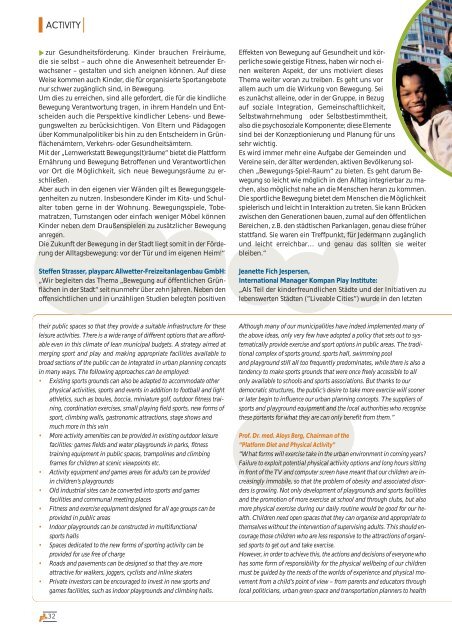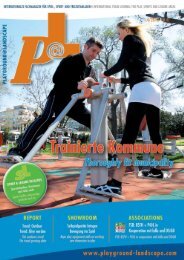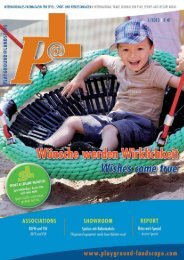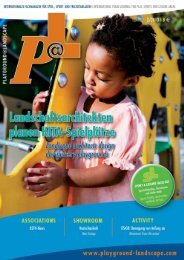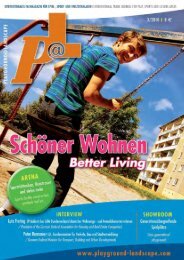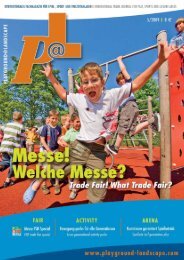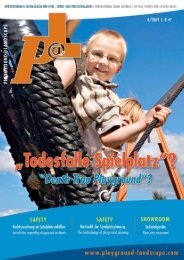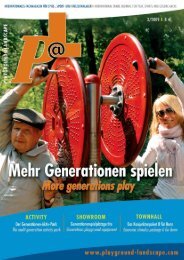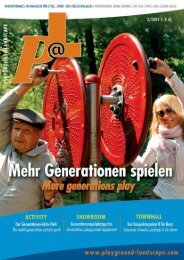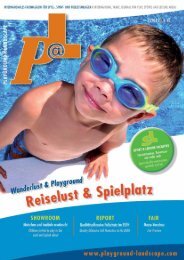Bürger-Engagement - Playground@Landscape
Bürger-Engagement - Playground@Landscape
Bürger-Engagement - Playground@Landscape
Sie wollen auch ein ePaper? Erhöhen Sie die Reichweite Ihrer Titel.
YUMPU macht aus Druck-PDFs automatisch weboptimierte ePaper, die Google liebt.
ACTIVITY<br />
zur Gesundheitsförderung. Kinder brauchen Freiräume,<br />
die sie selbst – auch ohne die Anwesenheit betreuender Erwachsener<br />
– gestalten und sich aneignen können. Auf diese<br />
Weise kommen auch Kinder, die für organisierte Sportangebote<br />
nur schwer zugänglich sind, in Bewegung.<br />
Um dies zu erreichen, sind alle gefordert, die für die kindliche<br />
Bewegung Verantwortung tragen, in ihrem Handeln und Entscheiden<br />
auch die Perspektive kindlicher Lebens- und Bewegungswelten<br />
zu berücksichtigen. Von Eltern und Pädagogen<br />
über Kommunalpolitiker bis hin zu den Entscheidern in Grünflächenämtern,<br />
Verkehrs- oder Gesundheitsämtern.<br />
Mit der „Lernwerkstatt Bewegungs(t)räume“ bietet die Plattform<br />
Ernährung und Bewegung Betroffenen und Verantwortlichen<br />
vor Ort die Möglichkeit, sich neue Bewegungsräume zu erschließen.<br />
Aber auch in den eigenen vier Wänden gilt es Bewegungsgelegenheiten<br />
zu nutzen. Insbesondere Kinder im Kita- und Schulalter<br />
toben gerne in der Wohnung. Bewegungsspiele, Tobematratzen,<br />
Turnstangen oder einfach weniger Möbel können<br />
Kinder neben dem Draußenspielen zu zusätzlicher Bewegung<br />
anregen.<br />
Die Zukunft der Bewegung in der Stadt liegt somit in der Förderung<br />
der Alltagsbewegung: vor der Tür und im eigenen Heim!“<br />
Steffen Strasser, playparc Allwetter-Freizeitanlagenbau GmbH:<br />
„Wir begleiten das Thema „Bewegung auf öffentlichen Grünflächen<br />
in der Stadt“ seit nunmehr über zehn Jahren. Neben den<br />
offensichtlichen und in unzähligen Studien belegten positiven<br />
their public spaces so that they provide a suitable infrastructure for these<br />
leisure activities. There is a wide range of different options that are affordable<br />
even in this climate of lean municipal budgets. A strategy aimed at<br />
merging sport and play and making appropriate facilities available to<br />
broad sections of the public can be integrated in urban planning concepts<br />
in many ways. The following approaches can be employed:<br />
Existing sports grounds can also be adapted to accommodate other<br />
physical activities, sports and events in addition to football and light<br />
athletics, such as boules, boccia, miniature golf, outdoor fitness training,<br />
coordination exercises, small playing field sports, new forms of<br />
sport, climbing walls, gastronomic attractions, stage shows and<br />
much more in this vein<br />
More activity amenities can be provided in existing outdoor leisure<br />
facilities: games fields and water playgrounds in parks, fitness<br />
training equipment in public spaces, trampolines and climbing<br />
frames for children at scenic viewpoints etc.<br />
Activity equipment and games areas for adults can be provided<br />
in children’s playgrounds<br />
Old industrial sites can be converted into sports and games<br />
facilities and communal meeting places<br />
Fitness and exercise equipment designed for all age groups can be<br />
provided in public areas<br />
Indoor playgrounds can be constructed in multifunctional<br />
sports halls<br />
Spaces dedicated to the new forms of sporting activity can be<br />
provided for use free of charge<br />
Roads and pavements can be designed so that they are more<br />
attractive for walkers, joggers, cyclists and inline skaters<br />
Private investors can be encouraged to invest in new sports and<br />
games facilities, such as indoor playgrounds and climbing halls.<br />
32<br />
Effekten von Bewegung auf Gesundheit und körperliche<br />
sowie geistige Fitness, haben wir noch einen<br />
weiteren Aspekt, der uns motiviert dieses<br />
Thema weiter voran zu treiben. Es geht uns vor<br />
allem auch um die Wirkung von Bewegung. Sei<br />
es zunächst alleine, oder in der Gruppe, in Bezug<br />
auf soziale Integration, Gemeinschaftlichkeit,<br />
Selbstwahrnehmung oder Selbstbestimmtheit,<br />
also die psychosoziale Komponente; diese Elemente<br />
sind bei der Konzeptionierung und Planung für uns<br />
sehr wichtig.<br />
Es wird immer mehr eine Aufgabe der Gemeinden und<br />
Vereine sein, der älter werdenden, aktiven Bevölkerung solchen<br />
„Bewegungs-Spiel-Raum“ zu bieten. Es geht darum Bewegung<br />
so leicht wie möglich in den Alltag integrierbar zu machen,<br />
also möglichst nahe an die Menschen heran zu kommen.<br />
Die sportliche Bewegung bietet dem Menschen die Möglichkeit<br />
spielerisch und leicht in Interaktion zu treten. Sie kann Brücken<br />
zwischen den Generationen bauen, zumal auf den öffentlichen<br />
Bereichen, z.B. den städtischen Parkanlagen, genau diese früher<br />
stattfand. Sie waren ein Treffpunkt, für Jedermann zugänglich<br />
und leicht erreichbar… und genau das sollten sie weiter<br />
bleiben.“<br />
Jeanette Fich Jespersen,<br />
International Manager Kompan Play Institute:<br />
„Als Teil der kinderfreundlichen Städte und der Initiativen zu<br />
lebenswerten Städten (”Liveable Cities”) wurde in den letzten<br />
Although many of our municipalities have indeed implemented many of<br />
the above ideas, only very few have adopted a policy that sets out to systematically<br />
provide exercise and sport options in public areas. The traditional<br />
complex of sports ground, sports hall, swimming pool<br />
and playground still all too frequently predominates, while there is also a<br />
tendency to make sports grounds that were once freely accessible to all<br />
only available to schools and sports associations. But thanks to our<br />
democratic structures, the public’s desire to take more exercise will sooner<br />
or later begin to influence our urban planning concepts. The suppliers of<br />
sports and playground equipment and the local authorities who recognise<br />
these portents for what they are can only benefit from them.”<br />
Prof. Dr. med. Aloys Berg, Chairman of the<br />
“Platform Diet and Physical Activity”<br />
“What forms will exercise take in the urban environment in coming years?<br />
Failure to exploit potential physical activity options and long hours sitting<br />
in front of the TV and computer screen have meant that our children are increasingly<br />
immobile, so that the problem of obesity and associated disorders<br />
is growing. Not only development of playgrounds and sports facilities<br />
and the promotion of more exercise at school and through clubs, but also<br />
more physical exercise during our daily routine would be good for our health.<br />
Children need open spaces that they can organise and appropriate to<br />
themselves without the intervention of supervising adults. This should encourage<br />
those children who are less responsive to the attractions of organised<br />
sports to get out and take exercise.<br />
However, in order to achieve this, the actions and decisions of everyone who<br />
has some form of responsibility for the physical wellbeing of our children<br />
must be guided by the needs of the worlds of experience and physical movement<br />
from a child’s point of view – from parents and educators through<br />
local politicians, urban green space and transportation planners to health


